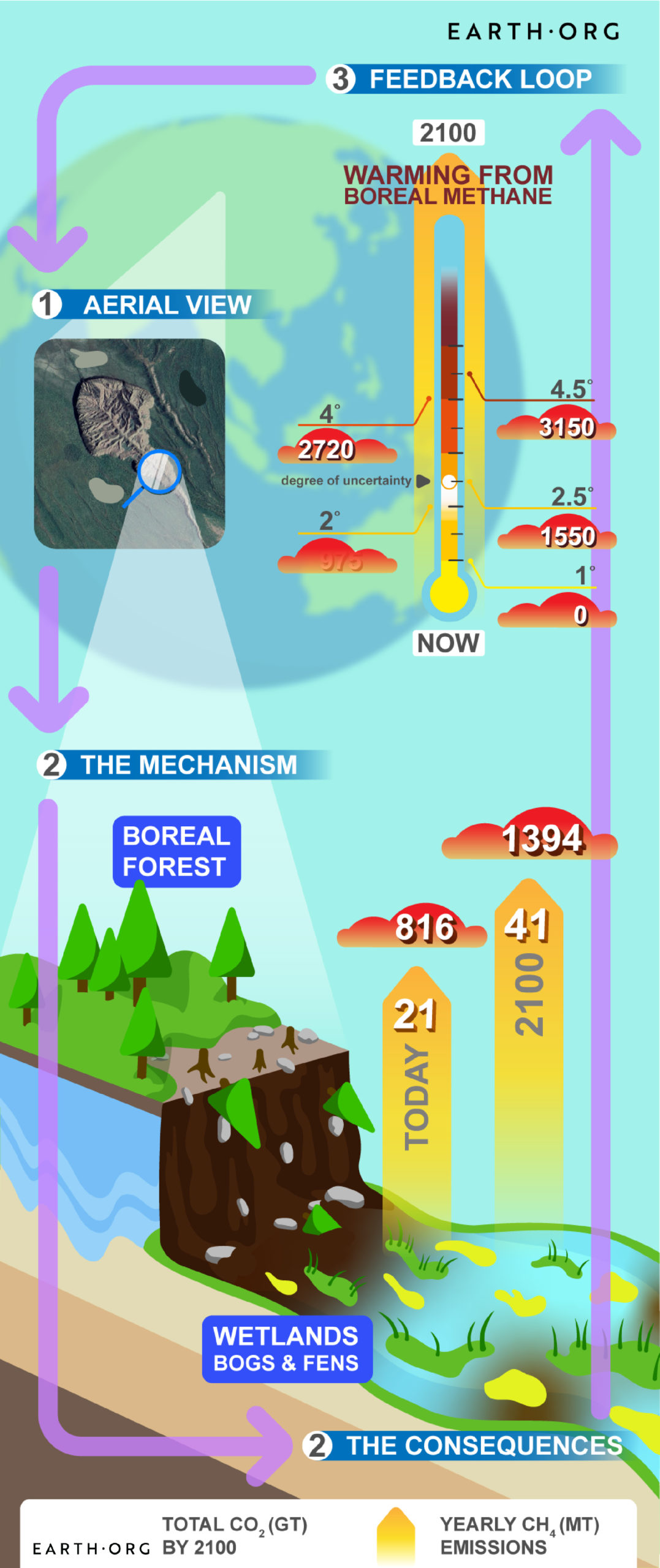Permafrost is ground that remains completely frozen (0°C or less) for at least two years straight. Almost a quarter of the Northern Hemisphere’s landmass has permafrost under its surface, propping up and keeping carbon-dense peatlands cool. Temperature rise is causing the Canadian permafrost to thaw, resulting in visible changes to the landscape and potentially huge methane emissions.
—
What is permafrost?
Permafrost is composed of sand, soil and rocks held together by ice, creating formations that can go down to 600 meters deep. Near the surface, permafrost-rich, boreal landscapes contain large quantities of organic carbon from dead plants that couldn’t decompose due to the cold temperatures. When permafrost thaws, bacteria decompose the organic matter and recycle it into methane, leading to more warming, which leads to more thawing… You get the picture.
Effects of Permafrost Thawing
Current models include permafrost thaw driven emissions to be substantial, but they only simulate gradual melt. A recent paper published by Nature states that around 20% of the planet’s permafrost is likely to thaw abruptly. This means collapsing ground, landslides and erosion, creating strange scenes like the so-called “drunken forests“.

Explanation of the mechanism and consequences of permafrost thaw in the Canadian boreal forest. Infographic by Jennifer Chan.
The danger of abrupt thaw is that the landscape changes drastically, and fast. One day, you are looking at a forest, the next, you find a three-meter deep lake. The dense reserves of carbon from ages of glaciation find themselves in a warm, soupy pool, ideal for bacterial degradation.
Temperature Rise, Wildfires and Permafrost
Temperatures are increasing about 3 times faster in the Arctic than the rest of the world , and this has led to a large increase in the number of boreal forest fires. As shade-providing trees are burnt away, the carbon-rich permafrosted lands are exposed.
Methane- and CO2-emitting microbes are mostly active during the warm season, from May to October. As temperatures in Siberia hit a 12,000 year high this year, this warm season will increase in length, thus increasing emission duration. Meanwhile, the decreased forest area will increase the amounts of carbon decomposed during said period, the combination of which will greatly increase total greenhouse gas emissions.
We have not yet fully estimated the impact of this process, but it is quite alarming. Nonetheless, methane-capturing and emission mitigating factors have been identified in the Arctic ecosystem, possibly providing us with some respite. Only time will tell.
This article was written by Owen Mulhern.
You might also like: Story By Numbers: The Greenland Ice Sheet
Disclaimer:
- Infographic: Current wetland emissions are the best current estimates, but these stem from models rather than direct measurements, and are unlikely to be exact.
References for Permafrost Thaw:
-
Thumbnail image: U.S. Geological Survey
-
Nisbet, E. G., et al. “Rising atmospheric methane: 2007–2014 growth and isotopic shift.” Global Biogeochemical Cycles 30.9 (2016): 1356-1370.
-
Treeline data by Brown, J., O. Ferrians, J. A. Heginbottom, and E. Melnikov. 2002.
-
Circum-Arctic Map of Permafrost and Ground-Ice Conditions, Version 2. Boulder, Colorado USA. NSIDC: National Snow and Ice Data Center. doi: https://doi.org/. 15/05/20.
-
Baltzer, Jennifer L., et al. “Forests on thawing permafrost: fragmentation, edge effects, and net forest loss.” Global Change Biology 20.3 (2014): 824-834.
-
Carbon Tracker (https://carbontracker.org/)
-
The Global Calculator (http://tool.globalcalculator.org/)
-
Zhang, Zhen, et al. “Emerging role of wetland methane emissions in driving 21st century climate change.” Proceedings of the National Academy of Sciences 114.36 (2017): 9647-9652.
-
Yale E360: Methane-Eating Bacteria Could Help Decrease Greenhouse Gas Emissions From Thawing Arctic Tundra
-
Turetsky, Merritt R., et al. “Carbon release through abrupt permafrost thaw.” Nature Geoscience 13.2 (2020): 138-143.










![The Statistics of Biodiversity Loss [2020 WWF Report]](https://u4d2z7k9.rocketcdn.me/wp-content/uploads/2020/12/lprwinkyTHB-544x306.jpg)





